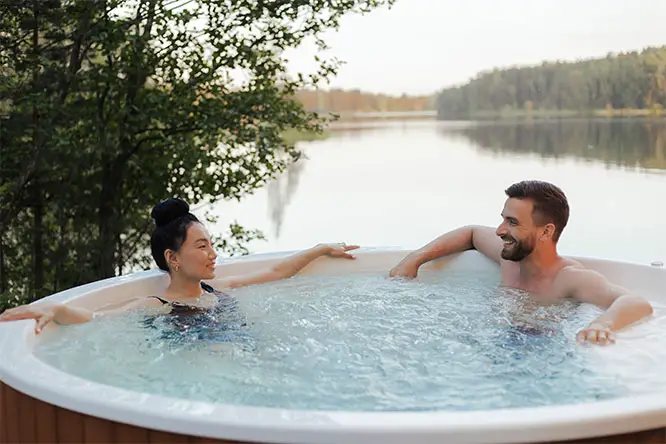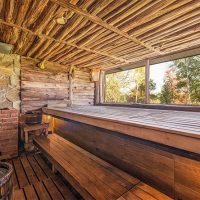Although many people differentiate between a sauna and a hot tub, when we add more terms to the mix, the lines get kind of blurry. They all offer certain health benefits (like muscle relaxation and detoxication), rely on heat, and are used to relax and relieve stress, but numerous differences set them firmly apart (at least some of them).
If we could group some of these terms, we could do it through their heat mediums. On one hand, spas, hot tubs, and Jacuzzi® tubs use warm water (hydrotherapy), while on the other, saunas and Turkish baths use heated air.
As far as other aspects are concerned, saunas are generally used individually, although there are large versions, while other facilities usually include enough space for multiple people. And all except the Turkish bath can be installed indoors or outdoors, but it’s more common to have them outside.
So let’s find out what other differences are there, how to tell all these terms apart, and which one seems best suited for your needs!
Sauna

Originating from Finland, saunas have recently become widely popular all over the globe. They started as a heating method for Finnish houses during the cold months and consisted of throwing water on hot stones, producing steam and dry heat. Now that process is conducted in a small room, typically with wooden walls, benches, stone stoves, and dim lighting.
Saunas are characterized by high temperatures and low humidity, which produces an environment perfect for shedding toxins and muscle relaxation, which can result in stress relief, improved sleeping quality and circulation, as well as hair and skin benefits.
Nevertheless, there are certain risks when using sauna users should be aware of, such as overheating, dehydration, and disturbed heart rate, which is why drinking water before and after use is essential.
In addition, proper ventilation is imperative in such a place, and in case of a ventilation failure, there is a chance of carbon monoxide poisoning. Needless to say, if you don’t feel well, get out immediately!
If you’re planning on purchasing a sauna unit for yourself, you should know that there are only a few options out there, and they use a lot of power. On the other hand, they are low maintenance, as they are easily cleaned and are less prone to bacteria than a Turkish bath.
Spa
The term ‘spa’ is used for several similar but different things. Firstly, we have spa & wellness centers that describe places that provide clients with health and beauty treatments, like cleansing services, mani-pedis, and massages. Also known as ‘day spas’, these establishments are frequently found in 4- and 5-star hotels but can also be an independent enterprise.
Secondly, we have spa resorts which are usually located near mineral-rich springs (hot springs are a good example) and provide users with healing baths and other health treatments.
And thirdly, ‘spa’ is used as an umbrella term, primarily used in the USA, that refers to water therapy and encompasses Jacuzzi® tubs, hot tubs, and other jetted bathtubs. The tubs in question are normally equipped with strong jets that create a massage effect and can accommodate a varying number of people, depending on the seating spaces.
There are above-ground (portable spas) and in-ground versions, which are sometimes installed adjacent to a pool, sharing its equipment (so-called pool and spa combo). The latter is especially popular in hotels and resorts.
In private residences, a spa is typically installed outdoors, but there are exceptions, especially if one thinks of every jetted tub as a spa. But the main difference is that an indoor jetted tub is a smaller, mainstream tub with jets and therefore gets drained after every use and doesn’t need a filter or a cover. These types of tubs are usually found in deluxe suites in some hotels and high-end apartments.
Hot tub

Just like ‘spa’ is used as an umbrella term for any large jetted tub, ‘hot tub’ is used for any large tub or small pool with heated water, with or without jets.
In case the hot tub in question includes jets, it can also be used for hydrotherapy (light massage that relaxes sore muscles), but it can also be used for fun and for hot tub parties as it normally offers seating for multiple people.
To make it more entertaining, hot tub owners can install different lighting options, speakers, fountains, and other accessories.
As well as other large tubs, hot tubs are usually installed outdoors and above ground, but there are in-ground and indoor versions. They are typically made out of acrylic and have independent plumbing and electric controls.
It is so common to have a hot tub outside that you can find hotels, lodges, log cabins, and accommodations with a private hot tub in every single region of the UK. Designed to enjoy a weekend break.
Although spas and Jacuzzis also use water, steam, and humidity (and sometimes air) to create a relaxing setting, a hot tub tends to be cheaper and more energy-efficient than a spa or a Jacuzzi tub.
Jacuzzi® tub
This term is probably the only one that is frequently wrongfully used. As much as the name is often used for any fancy jetted tub, Jacuzzi is a brand name and should only be used for products manufactured by this company.
In the 50s, the Jacuzzi brothers invented a specific portable hydrotherapy bathtub for arthritis patients. Some years later, they pioneered the creation of the first integrated jet whirlpool bath. Later their assortment was completed with large multi-user jetted tubs and other spa products.
As the biggest name in the spa world, their tubs are quite expensive and can be found almost exclusively in high-end hotels and spa centers, but some choose to cash out and buy them for private homes.
Turkish bath
If you are unfamiliar with the term, you might think that a Turkish bath (also called hammam) is a type of bathtub, but you would be wrong. It’s actually similar to a sauna as they are both steam based and help purify the body. Nevertheless, its origin is vastly different, as well as its functionality.
This story begins in the Ottoman Empire (Middle East). Inspired by ancient Greek and Roman bathing practices and their own bathing rituals, the Turks invented this ‘bath’ as a way of ritual purification.
Unlike saunas, steam rooms at Turkish baths are characterized by high humidity and lower temperature, but the heat is much more intense than in a dry space. This causes sweating which burns calories, opens the skin pores, and boosts the immune system.
Another difference is the size and decorum. A Turkish bath is spacious, lavishly decorated with marble walls and gold details, bright, and includes multiple rooms. You could spend several hours here, especially if you bring company.
Apart from the steam rooms that are heated with boiling water, users are also provided with other spaces where they can relax and cool off while visiting. There are massage rooms, steam rooms, cold-water showers (usually used at the end), soaking pools, washrooms, restrooms, and changing rooms.
Health benefits are undeniable but there are certain risks, of course. Because of high humidity, these places are prone to bacteria which can cause some health complications.
This is why it’s important to protect oneself, even if you are barely covered in these places. Bring your own flip-flops and towels you’ll use and sit on for minimum exposure to infections.
In conclusion, saunas and Turkish baths have a lot in common but differ in size, humidity, and temperature. Jacuzzi® tubs, spas, and hot tubs are obviously different from the previous two but are sometimes interchangeable with each other.
Spas are all baths with jets, hot tubs are all large tubs with warm water, and Jacuzzi® tubs are spa hot tubs made by the brand. Your overall physical and mental health can benefit from each of these, but you should always be aware of the potential risks, wash after every treatment, and keep in mind that they still don’t replace exercise and other healthy habits.
Author bio:
Alfonso Duane is a fitness coach, health buff, and wellness writer. He is passionate about integrating health and wellness into everyone’s lifestyle. Alfonso is also a consultant and author on his favorite topics.



